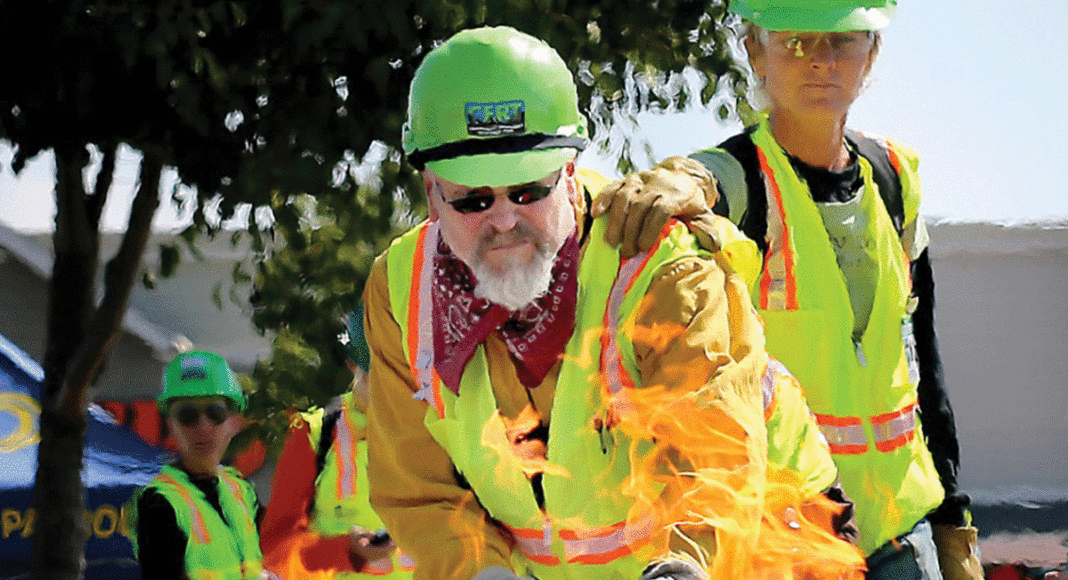There’s an adage these days that health care should not begin in the emergency room—given that preventative care is more impactful and more cost-effective than a last-minute trip to the ER when a patient is already in serious trouble. It is equally true that emergency preparation should not begin in the midst of a fire, flood, mudslide, or earthquake.
That’s why Santa Cruz County CERT, which stands for Community Emergency Response Team, brings neighbors together to train, plan and prepare for a wide variety of hazards before they happen. Safety is a serious concern this fall, as fires are raging throughout California. But CERT goes beyond thinking about worst-case scenarios.
“This is about community more than anything. It’s about neighbors learning to work as a cohesive unit,” says Santa Cruz County CERT executive director Mary Edmund, 69, of Aptos. “People expect the government to step in and handle things in an emergency. That’s a dangerous way of thinking. The government cannot do everything for us.”
This holiday season marks the first time that Santa Cruz County CERT has been selected to participate in the holiday fundraising program Santa Cruz Gives, a partnership between GT and the Santa Cruz County Volunteer Center.
A retired U.S. Army colonel, Edmund’s 30-year military career ranged from duty as a nurse to medical advisor for the chief of the U.S. Army Reserve. She spent the final 10 years of her career working for the undersecretary of defense for personnel and readiness at the Pentagon.
After retiring from the Army in 1996, Edmund moved to Santa Cruz County and became a self-described “career volunteer.” She spent 16 years with the Homeless Garden Project and more than 20 years with the Monterey Bay Master Gardeners.
When Edmund took a CERT class in 2012, she immediately realized the potential benefit of expanding the program across the county. The former colonel took it upon herself to do exactly that.
“Considering my background, CERT seemed like a natural fit, and I wanted to do something for my neighborhood,” Edmund says. “At that time, there were only one or two classes a year in the entire county. Watsonville hadn’t had a CERT class in nine years.”
Beyond the Basics
CERT plans to use its Santa Cruz Gives funds to partially cover the cost of training equipment, including two manikins, for search-and-rescue and disaster medicine training units. Edmund says the program aims to expand and adapt its FEMA-certified basic and advanced training to reflect the unique geographical areas in Santa Cruz County. She wants to develop a training branch that focuses on mountain communities’ needs and another that serves coastal communities.
Edmund says Santa Cruz County CERT operates on an annual budget of roughly $40,000. To date, the program has survived on grants and donations, yet a sudden drop off in donations has strained resources in 2018, she says.
“This year has been a tough one. I’m not sure if it was because of changes to the tax law or all the calls to action in the wake of the wildfires, but I’ve noticed the decrease,” Edmund says.
At the same time, demand for Santa Cruz County CERT’s classes is climbing. FEMA-certified instructors train volunteers in basic disaster response skills, such as fire safety, disaster medical operations and search and rescue.
“Last year we didn’t post our 2018 classes until January,” says Santa Cruz County CERT registrar Dawn Mackey. “This year we’re getting requests in October for classes in March of next year. People are jumping on registration. We’re seeing far more interest even than last year.”
Mackey, 70, has lived in Bonny Doon since 1974. She joined CERT three years ago because she wanted to help her neighborhood prepare for fire, heavy rains and other hazards. Mackey sees CERT as not only emergency preparedness, but also invaluable community building.
“In the event of an emergency, people may have to rely on one another for seven to 10 days, especially if they’re living in remote areas or places with limited access,” Mackey says.
Community exercises, such as Map Your Neighborhood, teach neighbors to rely on each other during the hours or days before fire, medical, police or utility responders arrive. Map Your Neighborhood also prompts neighbors to locate natural gas and propane tanks and create a contact list to identify the homes containing the elderly, disabled or children.
The FEMA-certified training classes are free to all residents of Santa Cruz County. The only requirements are time and the willingness to support your neighborhood and community, according to Mackey.
“When you’re done, you’re prepared to give first responders a specific, valuable map of your neighborhood when they arrive during an emergency,” Mackey said. “It can save them a lot of crucial time.”
For more information or to enroll in a Basic CERT Training class, visit santacruzcountycert.org. To donate to CERT Santa Cruz County as part of Santa Cruz Gives, visit santacruzgives.org through Monday, Dec. 31.












